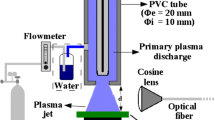Abstract
Recently, a glow like dielectric controlled barrier discharge (GDBD) working at atmospheric pressure has been observed. Such a discharge could replace a filamentary dielectric controlled barrier discharge (FDBD) used in corona treatment systems to improve the wettability or the adhesion of polymers. So it is of interest to compare these two types of discharges and their respective effect on a polymer surface. This is the aim of an extensive study we have undertaken. The first step presented here is the comparison of a filamentary discharge in air with a glow discharge in helium. Helium is the most appropriate gas to realize a glow discharge at atmospheric pressure. Air is the usual atmosphere for a corona treatment. The plasma was characterized by emission spectroscopy and current measurements. The surface transformations were indicated by the water contact angle, the leakage current measurement and the X-ray photoelectron spectroscopy. Results show that the helium GDBD is better than air FDBD to increase polypropylene wettability without decreasing the bulk electrical properties below a certain level. Contact angle scattering as well as leakage current measurements confirm that the GDBD clearly results in more reproducible and homogeneous treatment than the FDBD.
Similar content being viewed by others
REFERENCES
Messaoudi, A. Younsi, F. Massines, B. Despax, and C. Mayoux, IEEE Trans. Dielectric Elect. Insul. 3,4, 537 (1996).
J. Salge, J. Phys. IV 5, C5-583 (1995).
A. Von Engel, A. Seeliger, and M. Steenbeck, Z. Phys. 85, 144 (1933).
R. Bartnikas, IEEE Trans. Elect. Insul. EI-6,2, 63 (1971).
M. Stradal and D. A. I. Goring, Can. J. Chem. Eng. 53, 427 (1975).
S. Kanazawa, M. Kogoma, T. Moriwaki, and S. Okazaki, J. Phys. D: Appl. Phys. 21, 838 (1988).
S. Okazaki, M. Kogoma, and H. Uchiyama, Proc. Third Int. Symp. on High Pressure Low Temp. Plasma Chem. (HAKONE III), Strasbourg, France, September 101 (1991) 3-5.
Y. Sawada, S. Ogawa, and M. Kogoma, J. Phys. D: Appl. Phys. 28, 1661 (1995).
F. Massines, R. Ben Gadri, Ph. Decomps, A. Rabehi, P. Ségur, and Ch. Mayoux, in Penomena in ionized gazes, K. E. Becker, (ed.), American Institute of Physics Conference Proceeding 363, (1996) p. 306.
B. Eliasson and U. Kogelschatz, IEEE Trans. Plasma Sci. 19,2, 309 (1991).
M. Kogoma and S. Okazaki, J. Phys. D: Appl. Phys. 27, 1985 (1994).
C. Liu, P. P. Tsai, and J. R. Roth, Proc. 20th IEEE Int. Conf. Plasma Sci., Vancouver, Canada, June 7–9, (1993).
J. Lopez, B. Despax, and C. Mayoux, Tenth Conf. Elect. Insul. Dielectric Phenomena (CEIDP 10), Proceeding IEEE 87CH2462-0, Gaithesburg, October, (1987) p. 251.
A. A. Radzig and B. M. Smirnov, in Reference Data on Atoms, Molecules and Ions, Springer series in Chemical Physics, (1985) p. 31.
A. Ricard and J. Lefebvre, Analusis 6, 7, 299 (1978).
F. Massines, T. Lebey, and C. Mayoux, Fourth Int. Conf. on Conduction and Breakdown in Solid Dielectrics (ICSD 4), Proceeding IEEE 92CH3034-6, Sestri, June 22–25, (1992) p. 518.
J. Sarlaboux and C. Mayoux, IEEE Symp. Elect. Insul., Montréal, June 11–13, (1984) p. 121.
J. Sarlaboux and C. Mayoux, J. Phys. D: Appl. Phys. 22, 13 (1979).
T. Yokoyama, M. Kogoma, S. Kanazawa, T. Moriwaki, and S. Okazaki, J. Phys D: Appl. Phys. 23, 374 (1990).
E. Occhiello, M. Morra, G. Morini, F. Garbassi, and P. Humphrey, J. Appl. Polym. Sci. 42, 551 (1991).
I. Sutherland, R. P. Popat, D. M. Brewis, and R. Calder, J. Adhesion 46, 78 (1994).
B. Eliason, M. Hirth, and U. Kogelschartz, J. Phys. D: Appl. Phys. 20, 1421 (1987).
E. Landers, Proc. IEEE 125, 1069 (1978).
M. J. Walzak, S. Flynn, R. Foerch, J. M. Hill, E. Karbasheski, A Lin, and M. Strobel, J. Adhesion Sci. Tech. 9,9, 1229 (1995).
J. Stevefelt, J. M. Pouvesle, and A. Bouchoule, J. Chem. Phys. 76,8, 4006 (1982).
M. Tatoulian, F. Arefi-Khonsari, I. Mabille-Rouger, J. Amouroux, M. Gheorgiu, and D. Bouchier, J. Adhesion Sci. Tech. 9,7, 923 (1995).
S. Nowak and O. M. Küttel, Mater. Sci. Forum 140–142, 705 (1993).
J. M. Lane and D. J. Hourston, Progress in Organic Coating 21, 269 (1993).
S. Saphieha, J. Cerny, J. E. Klemberg-Saphieha, and L. Martinu, J. Adhesion 42, 91 (1993).
E. Marode, F. Bastien, and M. Bakker, 1979 J. Appl. Phys. 50,1, 140-146 (1979).
C. Mayoux, IEEE Trans. Elect. Ins. E1-11,4, 139 (1986).
M. Goldman, A. Goldman, and J. Gatelet, Int. Conf. Partial Discharge, Canterbury (UK), September 28–30, (1993) p. 11.
C. Mayoux, IEEE Trans. Dielectric Elect. Insul. 1,5, 785 (1994).
Author information
Authors and Affiliations
Rights and permissions
About this article
Cite this article
Massines, F., Messaoudi, R. & Mayoux, C. Comparison Between Air Filamentary and Helium Glow Dielectric Barrier Discharges for the Polypropylene Surface Treatment. Plasmas and Polymers 3, 43–59 (1998). https://doi.org/10.1023/A:1022582017499
Issue Date:
DOI: https://doi.org/10.1023/A:1022582017499




